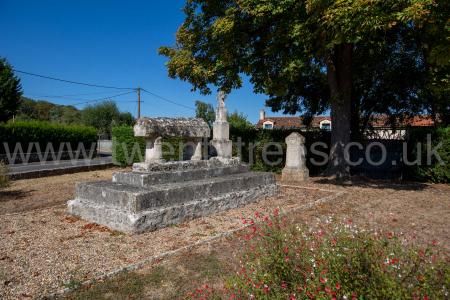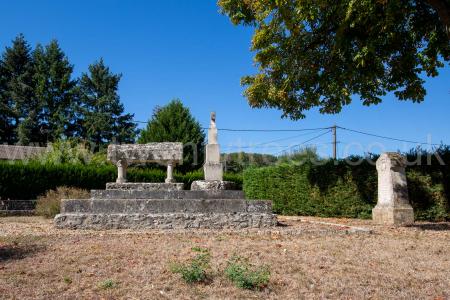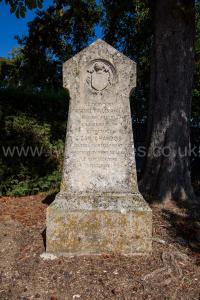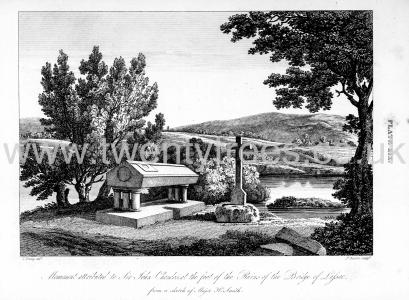Biography of John Chandos 1320-1369
Around 1320 John Chandos was born at Radbourne Hall [Map].
Froissart. 1339. When the Friday came in the morning, both hosts apparelled themselves ready, and every lord heard mass among their own companies and divers were shriven.
First we will speak of the order of the Englishmen, who drew them forward into the field and made three battles afoot, and did put all their horses and baggages into a little wood behind them, and fortified it. The first battle led1 the duke of Gueldres, the marquis of Meissen, the marquis of Brandebourg, sir John of Hainault, the earl of Mons, the earl of Salm, the lord of Fauquemont, sir William of Duvenvoorde, sir Arnold of Baquehem and the Almains; and among them was twenty-two banners and sixty pennons in the whole, and eight thousand men. The second battle had the duke of Brabant and the lords and knights of his country - first the lord of Cuyk, the lord Berg, the lord of Breda, the lord of Rotselaer, the lord of Vorsselaer, the lord of Borgneval, the lord of Schoonvorst, the lord of Witham, the lord of Aerschot, the lord of Gaesbeck, the lord of Duffel, sir Thierry of Walcourt, sir Rasse of Gres, sir John of Kesterbeke, sir John Pyliser, sir Giles of Coterebbe, sir Walter of Huldeberg, the three brethren of Harlebeke, sir Henry of Flanders, and divers other barons and knights of Flanders, who were all under the duke of Brabant's banner, as the lord of Halewyn, the lord of Gruthuse, sir Hector Vilain, sir John of Rhodes, sir Wulfart of Ghistelles, sir William of Straten, sir Gossuin de la Moere, and many other: the duke of Brabant had a twenty-four banners and eighty pennons, and in all a seven thousand men. The third battle and the greatest had the king of England and with him his cousin the earl of Derby (age 29), the bishop of Lincoln (age 47), the bishop of Durham, the earl of Salisbury (age 38), the earl of Northampton (age 29), and of Gloucester (age 48), the earl of Suffolk (age 40), sir Robert d'Artois (age 52), as then called earl of Richmond5, the lord Raynold Cobham (age 44), the lord Percy, the lord Ros (age 54), the lord Mowbray (age 28), sir Lewis and sir John Beauchamp, the lord Delaware (age 62), the lord of Langton, the lord Basset, the lord Fitzwalter, sir Walter Manny (age 29), sir Hugh Hastings (age 29), sir John Lisle (age 20), and divers other that I cannot name: among other was sir John Chandos (age 19), of whom much honour is spoken in this book2. The king had with him twenty-eight banners and ninety pennons, and in his battle a six thousand men of arms and six thousand archers; and he had set another battle as in a wing, whereof the earl of Warwick (age 25), the earl of Pembroke (age 19), the lord Berkeley (age 43), the lord Multon and divers other were as chief, and they were on horseback3. Thus when every lord was under his banner, as it was commanded by the marshals, the king of England mounted on a palfrey, accompanied all only with sir Robert d'Artois (age 52), sir Raynold Cobham (age 44) and sir Walter of Manny, and rode along before all his battles, and right sweetly desired all his lords and other that they would that day aid to defend his honour. And they all promised him so to do. Then he returned to his own battle and set everything in good order and commanded that none should go before the marshals' banners.













Now let us speak of the lords of France, what they did. They were eleven score banners, four kings, six dukes, twenty-six earls, and more than four thousand knights, and of the commons of France more than sixty thousand. The kings that were there with king Philip of Valois was the king of Bohemia, the king of Navarre, and king David of Scotland: the duke of Normandy, the duke of Bretayne, the duke of Bourbon, the duke of Lorraine and the duke of Athens: 2 of earls, the earl of Alencon (age 42) brother to the king, the earl of Flanders, the earl of Hainault, the earl of Blois, the earl of Bar, the earl of Forez, the earl of Foix, the earl of Armagnac, the earl Dolphin of Auvergne, the earl of Joinville, the earl of Etampes, the earl of Vendome, the earl of Harcourt, the earl of Saint-Pol, the earl of Guines, the earl of Boulogne, the earl of Roucy, the earl of Dammartin, the earl of Valentinois, the earl of Auxerre, the earl of Sancerre, the earl of Geneva, the earl of Dreux; and of Gascoyne and of Languedoc so many earls and viscounts, that it were long to rehearse. It was a great beauty to behold the banners and standards waving in the wind, and horses barded, and knights and squires richly armed. The Frenchmen ordained three great battles, in each of them fifteen thousand men of arms and twenty thousand men afoot.
Note 1. Perhaps a misprint for 'had.' The original is 'eut.'
Note 2. In the later revision the writer says: 'I, Froissart, writer of these chronicles, more than once heard the gentle knight sir John Chandos say that he was made knight by the hand of the king Edward of England on this Friday that the assembly was at Buironfosse; and since that he was more valiant than any other who took arms on the side of the English, I make mention of this here.'
Note 3. The original says: ' So these remained on horseback to support those battles which should waver, and were as a rear-guard.'
Note 4. The name of the duke of Burgundy is omitted.
Note 5. TT. Robert III Artois (age 52) wasn't created Earl Richmond until 1341?
On 23 Apr 1344 King Edward III of England (age 31) created the Order of the Garter. The date nominal as there are different accounts; some sources say 1348.
2 Henry of Grosmont 1st Duke Lancaster.
3 Thomas Beauchamp 11th Earl Warwick.
4 Jean Grailly.
5 Ralph Stafford 1st Earl Stafford.
6 William Montagu 2nd Earl Salisbury.
7 Roger Mortimer 2nd Earl March.
9 Bartholomew "The Younger" Burghesh 2nd Baron Burghesh.
10 John Beauchamp 1st Baron Beauchamp Warwick.
11 John Mohun 2nd Baron Mohun of Dunster.
12 Hugh Courtenay.
13 Thomas Holland 1st Earl Kent.
15 Richard Fitzsimon.
16 Miles Stapleton.
17 Thomas Wale.
18 Hugh Wrottesley.
19 Neil Loring.
20 John Chandos.
21 James Audley.
22 Otho Holland.
23 Henry Eam.
24 Sanchet Abrichecourt.
On 26 Aug 1346 the army of King Edward III of England (age 33) defeated the French army at the Battle of Crécy. The English army was commanded by King Edward III of England (age 33), his son Edward "Black Prince" (age 16), Thomas Beauchamp 11th Earl Warwick (age 33), William Bohun 1st Earl of Northampton (age 36) and John Beauchamp 1st Baron Beauchamp Warwick (age 30).


The English army was included: Bishop Thomas of Hatfield (age 36), Hugh Despencer 1st Baron Despencer (age 38), Bernard Brocas (age 16), Thomas Felton (age 16), James Audley (age 28), Robert Bourchier 1st Baron Bourchier, Bartholomew "The Elder" Burghesh 1st Baron Burghesh (age 59), Bartholomew "The Younger" Burghesh 2nd Baron Burghesh (age 18), Reginald Cobham 1st Baron Cobham (age 51), John Darcy 1st Baron Darcy of Knayth (age 66), Robert Ferrers 3rd Baron Ferrers of Chartley (age 37), Richard Scrope 1st Baron Scrope of Bolton (age 19), William Scrope (age 21), Stephen Scrope (age 21), William Latimer 4th Baron Latimer of Corby (age 16), John Lisle 2nd Baron Lisle (age 28), Gerard Lisle 1st Baron Lisle (age 42), Nicholas Longford (age 61), Edward Montagu 1st Baron Montagu, Walter Paveley 4th Baron Burghesh (age 27), Michael Poynings 1st Baron Poynings (age 28), Robert Ufford 1st Earl Suffolk (age 48), John de Vere 7th Earl of Oxford (age 34), Thomas West (age 34), John Willoughby 2nd Baron Willoughby (age 43), John Wingfield (age 26), Henry Percy 11th and 3rd Baron Percy (age 25), Hugh Courtenay 10th Earl Devon (age 43) (possibly), Walter "Elder" Devereux (age 37), John Devereux (age 44), Enion Sais Brecon, John Chandos (age 26), Richard Pembridge (age 26) and John Sully (age 63).

















The French army suffered significant casualties. King Philip "Fortunate" VI of France (age 52) was wounded. William de Coucy (age 60) and his son Enguerrand 6th Lord de Coucy (age 33) and were killed.
Charles Valois Count Alençon (age 49) was killed. His son Charles Valois Archbishop Lyons (age 9) succeeded Count Alençon.
Louis Chatillon II Count Blois I Count Chatillon was killed. His son Louis Chatillon III Count Blois Count Soissons succeeded III Count Blois.
Louis Dampierre II Count Nevers I Count Flanders (age 42) was killed. His son Louis Dampierre III Count Nevers II Count Flanders (age 15) succeeded III Count Nevers, II Count Flanders.
King John I of Bohemia (age 50) was killed. His son Charles IV King Bohemia Holy Roman Emperor Luxemburg (age 30) succeeded IV King Bohemia.
Rudolph "Valiant" Metz I Duke Lorraine (age 26) was killed. His son John Metz I Duke Lorraine succeeded I Duke Lorraine.
Jean IV de Harcourt (age 39) was killed.
On 19 Sep 1356 the army of Edward "Black Prince" (age 26) defeated the French and Scottish army led by King John "The Good" II of France (age 37) at the Battle of Poitiers

King John "The Good" II of France (age 37) was captured by three captains including Ivon aka John Fane.

The the English army included: Bernard Brocas (age 26), Thomas Felton (age 26), James Audley (age 38), Thomas Beauchamp 11th Earl Warwick (age 43), Bartholomew "The Younger" Burghesh 2nd Baron Burghesh (age 28), Reginald Cobham 1st Baron Cobham (age 61), Edward Despencer 1st Baron Despencer, Baron Burghesh (age 21), Ralph Ferrers (age 27), William Scrope (age 31), William Montagu 2nd Earl Salisbury (age 28), Walter Paveley 4th Baron Burghesh (age 37), Robert Ufford 1st Earl Suffolk (age 58), William Ufford 2nd Earl Suffolk (age 18), John de Vere 7th Earl of Oxford (age 44), John Willoughby 3rd Baron Willoughby (age 33), Thomas Arderne (age 19), Enion Sais Brecon, John Chandos (age 36), Richard Pembridge (age 36), Jean Grailly (age 25), Robert de Fouleshurst (age 26) and John Sully (age 73)










John Savile of Shelley and Golcar (age 31) probably fought having received letters of protection to travel overseas.
Hugh Courtenay 10th Earl Devon (age 53) protected the baggage train.
The French and Scottish army included: King John "The Good" II of France (age 37), Philip "Bold" Valois II Duke Burgundy (age 14), Jean Bourbon I Count La Marche (age 12), Archibald "Grim" Douglas 3rd Earl Douglas (age 26), John "Sans Terre" Artois 1st Count Eu (age 35); all captured.
Guichard d'Angle 1st Earl Huntingdon and William Douglas 1st Earl Douglas (age 33) fought.
Peter Bourbon Duke Bourbon (age 45) was killed. His son Louis Bourbon II Duke Bourbon (age 19) succeeded II Duke Bourbon.
In 1360 John Chandos (age 40) was created Knight Banneret.
On 29 Sep 1364 Battle of Auray decided the Breton Succession in favour of John Montfort V Duke Brittany (age 25). The Breton and English army was commanded by John Chandos (age 44) and included William Latimer 4th Baron Latimer of Corby (age 34), Miles Stapleton (age 44) and Hugh Calverley (age 40). Charles "Saint" Chatillon Duke Brittany (age 45) was killed. Bertrand Geusclin (age 44) surrendered. 

On 31 Dec 1369 John Chandos (age 49) was killed. Chandos' force retreated towards the bridge across the Vienne at Lussac-les-Châteaux, along the route to Poitiers through Chauvigny. The French, unaware of their presence, had decided to follow the same route to harass any English troops. The adversaries met at the bridge of Lussac. In the battle, Chandos' long coat made him slip on the frost. James de Saint-Martin, a squire in the house of Sir Bagnac (or Guillaume Boitel, according to Paul Hay du Chastelet) struck Chandos with his lance, piercing his face below the eye. Chandos' uncle Edward Twyford, standing over his wounded nephew, repulsed the attackers. One of his squires pierced both legs of James Saint-Martin with his sword; Saint-Martin died three days later at Poitiers. John Chandos was carried on a large shield to Morthemer, the nearest English fortress. He was buried at Les Aubeniaux, Mazerolles where there is a monument.



Archaeologia Volume 20 Section V. Account of the Tomb of Sir John Chandos, Knt. A.D. 1370, at Civauux a hamlet on the Vienne, in France; by Samuel Rush Meyrick (age 40), LL. D. F.S.A. In a Letter addressed to Henry Ellis, Esq. F. R. S. Secretary. Read 5th April 1821.
